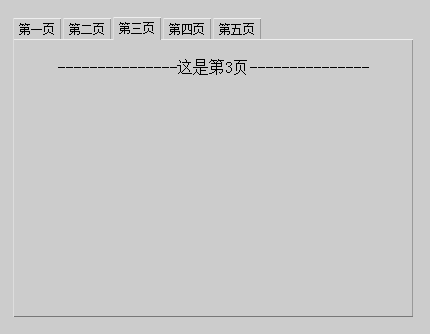
L'exemple de cet article décrit l'implémentation d'un code de changement d'onglet de style classique Windows de type JS. Partagez-le avec tout le monde pour votre référence, les détails sont les suivants :
Cet onglet d'imitation de style Windows a une sensation tridimensionnelle grise. L'exemple de contenu utilise JS pour contrôler la sortie. Il s'agit simplement de démontrer la fonction. Vous pouvez le supprimer complètement lorsque vous l'utilisez.
La capture d'écran de l'effet en cours d'exécution est la suivante :

L'adresse de la démo en ligne est la suivante :
http://demo.jb51.net/js/2015/js-f-windows-style-tab-demo/
Le code spécifique est le suivant :
<!DOCTYPE html PUBLIC "-//W3C//DTD XHTML 1.0 Transitional//EN"
"http://www.w3.org/TR/xhtml1/DTD/xhtml1-transitional.dtd">
<html xmlns="http://www.w3.org/1999/xhtml">
<head>
<meta http-equiv="Content-Type" content="text/html; charset=gb2312" />
<title>选项卡</title>
<style type="text/css">
body{
background-color:#CCC;
}
.tab{
margin:0;
padding:0;
position:absolute;
}
.tab li{
float:left;
list-style:none;
}
.tab li span{
float:left;
display:block;
height:20px;
line-height:20px;
position:relative;
border-style:solid;
border-width:1px 1px 0 1px;
border-color:#EEE #999 #777 #DDD;
background-color:#CCC;
margin:1px 2px 0 0;
padding:0 5px 0 5px;
font-size:12px;
cursor:pointer;
z-index:1;
}
.tab li div{
display:none;
position:absolute;
top:22px;
left:0px;
background-color:#CCC;
border:1px solid;
border-color:#EEE #999 #777 #DDD;
text-align:center;
overflow:auto;
}
.tab li.selected span{
margin-top:0;
height:22px;
}
.tab li.selected div{
display:block;
}
</style>
<script type="text/javascript">
function CreateTab(tab_width,tab_height,parent_obj){
var newtab=document.createElement("UL");
newtab.className="tab";
parent_obj.appendChild(newtab);
Tab.call(newtab);
newtab.style.width=tab_width+"px";
newtab.style.height=tab_height+"px";
return newtab;
}
function Tab(){
var this_tab=this;
this.selected_page;
this.page_names=new Array();
this.page_contents=new Array();
this.Select=function(){
this_tab.selected_page.className="";
this.className="selected";
this_tab.selected_page=this;
}
this.NewPage=function(page_name){
var newpage=document.createElement("LI");
newpage.onclick=this.Select;
newpage.innerHTML="<span>"+page_name+"</span><div></div>";
this.appendChild(newpage);
newpage.lastChild.style.width=parseInt(this.style.width)-2+"px";
newpage.lastChild.style.height=parseInt(this.style.height)-24+"px";
this.page_names.push(newpage.firstChild);
this.page_contents.push(newpage.lastChild);
return newpage;
}
this.SetChecked=function(page_index){
if(page_index>-1&&this.childNodes.length>page_index){
this.selected_page=this.childNodes[page_index];
this.selected_page.className="selected";
}
}
}
</script>
</head>
<body>
<script type="text/javascript">
var newtab=CreateTab(400,300,document.body);
newtab.NewPage("第一页");
newtab.NewPage("第二页");
newtab.NewPage("第三页");
newtab.NewPage("第四页");
newtab.NewPage("第五页");
newtab.SetChecked(0);
newtab.style.top="100px";
newtab.style.left="200px";
for(var i=0;i<newtab.childNodes.length;i++){
newtab.page_contents[i].innerHTML=function(number){
var content_str="";
for(var n=0;n<1;n++){
content_str+="<br />---------------这是第"+number+"页---------------";
}
return content_str;
}(i+1);
}
</script>
</body>
</html>
J'espère que cet article sera utile à tout le monde dans la programmation JavaScript.